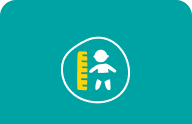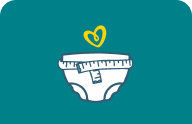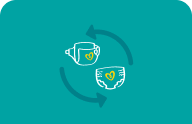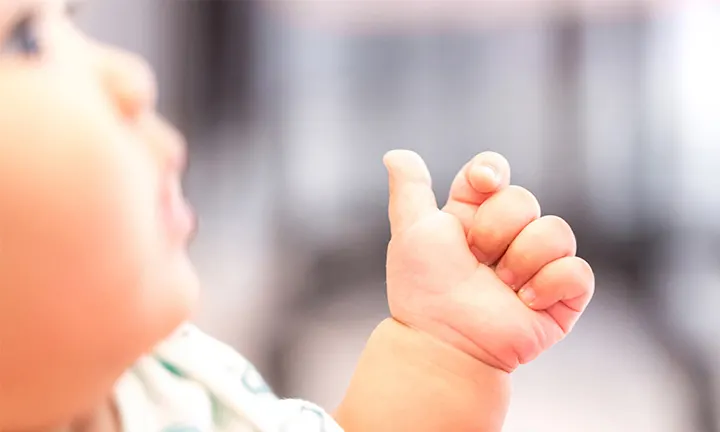Explore
Diapering
Tools you might be interested in
Tips for Teaching Baby Sign Language
Teaching your baby basic words through sign language could help you communicate with each other before your baby learns how to speak—and the good news is that signing won’t delay speech in children. Find out more about baby sign language, get some tips for teaching it to your baby or toddler, and learn some of the common signs that you can get started with.
What Is Baby Sign Language?
Sign language for babies has become pretty popular in the past 20 years—you probably know of some hit movies that have featured it! The popularity of sign language may be due in part to the fact that many babies can be taught to use their hands to “talk” sooner than they can learn speech. Baby sign language gives babies and young toddlers (between 8 months and 2 years) a way to communicate before they can say their first words.
This may ease some of the frustration they might feel when not able to clearly express their needs or feelings yet. Knowing that your baby can convey some of those basic wants and needs through signing may take some of the guesswork out of parenting, too, as your little one may be able to tell you if they’re hungry or sleepy, for example. Of course, it will take time before your baby has the dexterity to use their hands in that way. Baby sign language may be a way for your baby to communicate starting at about 8 or 9 months old or a little later on.
If you’re concerned that signing will delay your little one’s speech, have no worries! Research has shown that learning sign language doesn’t delay speech development. Keep in mind that teaching your baby sign language is optional. It’s just one tool you could use to communicate with your little one at a time when your baby may have something to say but can’t yet communicate with speech.
How Do You Do Sign Language for Babies?
Sign language is an expressive form of communication that utilizes hand gestures, facial expressions, and body movements to convey meaning. Learning how to sign, especially for communicating with your baby, can enhance early communication and bond formation. You can start teaching baby sign language early in infancy—experts suggest starting at around 6 or 7 months. Just be aware that babies probably won’t be able to communicate using baby sign language until they are at least 8 months old
Is Baby Sign Language the Same as ASL?
It’s important to know that baby sign language is different from the sign language that’s used by the hearing impaired. In some cases, baby sign language uses modified gestures from American Sign Language (ASL), making it similar but not the same. Baby sign language often uses simplified signs rather than the complex grammar and sentence structures of other types of sign language.
Common Sign Language Words for Babies
Below you’ll find some common baby sign language gestures (some of them similar to ASL signs) that may be useful for your little one to learn. These basic words are common in a baby’s daily life, such as when they’re hungry or want their mom or dad.
How to Say “Yes” in Baby Sign Language
To sign “yes” in baby sign language, make a fist with your dominant hand and then nod the fist up and down, mimicking the head movement of nodding “yes.”

How to Say “No” in Baby Sign Language
The word “no” in baby sign language is actually the same as American sign language. Extend your thumb, index, and middle fingers, then tap them together a few times. This gesture resembles a mouth saying “no.”

How to Say “Please” in Baby Sign Language
As well as teaching your little one some basic signs, you can teach them some good manners when asking for something. Baby sign language for “please,” involves using an open flat hand to make a circular motion on your chest. This motion is generally done clockwise.

How to Say “More” in Baby Sign Language
To sign the word “more,” in baby sign language, pinch your fingertips together on both hands and then tap your fingertips together a few times.

How to Say “You are Welcome” in Baby Sign Language
To sign “you are welcome,” simply extend your fingers and thumb out flat, and sweep your hand outward from your chin, almost as if you are blowing a kiss.

How to Say “All Done” in Baby Sign Language
To sign “all done,” start with both hands up with palms facing you, then turn both hands outward and away from your body.

How to Say “Hungry” in Baby Sign Language
The word “hungry” in baby sign language involves making a C-shaped hand and moving it down from your chest to your stomach, mimicking the motion of food going down into your stomach.

How to Say “Eat” in Baby Sign Language
To sign the word “eat” in baby sign language, bring your fingertips to your mouth as if you’re putting food into your mouth.

How to Say “Drink” in Baby Sign Language
The sign for “drink” is pretty easy for babies to learn. It involves making a C-shaped hand and mimicking the action of tilting a cup into your mouth.

How to Say “Milk” in Baby Sign Language
Teach your little one baby sign language for “milk” by opening and closing your hand as if milking a cow.

How to Say “Water” in Baby Sign Language
The sign for “water,” involves forming a W with your three fingers (thumb, index, and middle finger), and tapping your index finger on your chin.

How to Say “Poop” in Baby Sign Language
To sign “poop,” make a fist with both hands, one fist stacked over the other. Extend the thumb of the bottom fist and tuck it inside the upper fist. Then move the lower fist down, keeping the thumb extended.

How to Say “Play” in Baby Sign Language
The word “play” in baby sign language is performed by using both hands to mimic a playful motion, with both Y-shaped hands (thumb and pinky extended, other fingers tucked in) twisting around each other.

How to Say “Share” in Baby Sign Language
To sign “share” in baby sign language extend one hand flat with palm up, and with your other hand's index and middle finger, mimic slicing or cutting into the palm, indicating dividing something to share.

How to Say “Sleep” in Baby Sign Language
This is a great one for your baby to use if they want to take a nap or are ready for bedtime. To sign “sleep” in baby sign language, extend your fingers and from a flat hand position, draw your hand downward across your face, closing your fingers towards your thumb as the hand passes over your eyes, mimicking the action of closing your eyes to sleep.

How to Say “Up” in Baby Sign Language
To sign “up,” point your index finger upward and move your hand up toward the sky.

How to Say “Sorry” in Baby Sign Language
To sign “sorry,” form a fist with one hand and move it in a circular motion across your chest, as if rubbing over your heart.

How to Say “Bath” in Baby Sign Language
Make the sign for “bath” in baby sign language by making fists with both hands and sticking your thumbs out. Move your fists up and down your chest as if scrubbing yourself.

How to Say “Dad” in Baby Sign Language
Whether you want to learn the sign for “dad,” “father,” or “daddy” in baby sign language, know that they all have the same sign. Open your five fingers and tap your thumb on your forehead.

How to Say “Mom” in Baby Sign Language
This one is similar to the sign for “dad;” however, to sign “mom,” “mommy,” or “mama” in baby sign language, open your five fingers and tap your thumb on your chin.

How to Say “Bye” in Baby Sign Language
To sign “bye,” open your hand with your fingers extended and fold your fingers down, before opening them up again.

How to Say “Can” in Baby Sign Language
To sign “can,” make two fists and hold them up. Then move them forward and downward while nodding your head with a look of encouragement.

Basic Baby Sign Language Chart
Check out the following infant sign language chart for our favorite basic and practical words you can teach your baby.

How to Teach Baby Sign Language
If you’re wondering how to teach your infant sign language, the good news is that learning baby sign language and teaching it to your little one isn't that difficult, though the process will require consistent effort, lots of repetition, and patience on your part. Here are some tips for teaching baby sign language to your little one:
Start simple. Pick a few signs that would be meaningful for your child. For example, if their favorite activity is going to the park, teach them the sign for “park.”
Get interactive. As you go about your daily activities with your baby, include the appropriate sign. Try signing the word diaper while changing their diaper, food when feeding them, or book when reading them a bedtime story. Go ahead and sign words like eat or drink during mealtimes, or daddy when your child’s father walks into the room.
Develop a routine. Sit your baby on your lap with their back to your stomach, and show them the signs by articulating their arms and hands while saying the word you’re signing. Repetition will be the key to their learning, so take every opportunity to sign. Try to sign with them every day. In time your baby will learn to connect the word with the sign, and may start to use it.
Give it time. Don’t get frustrated or discouraged if your baby doesn’t pick up on sign language as quickly as you had hoped, or if they don’t get the signs quite right the first time. As with all new skills, learning baby sign language takes time.
Make it fun. Signing lessons can be the perfect time for bonding with your little one. Give lots of encouragement when your baby signs a word by praising, kissing, or hugging them. Make the lessons even more fun by signing and singing popular songs and lullabies, like “Twinkle, Twinkle, Little Star” or “Hush Little Baby,” and selecting some key words from the songs to sign to them. If you find that you’re not enjoying teaching baby sign language, you might consider not doing it.
Keep speaking. Just because your baby knows how to communicate using baby sign language doesn’t mean you should be talking to them any less frequently. Signing shouldn’t and doesn't take the place of speaking. Continue talking to your baby as often as you can, encouraging their responses, and keep enjoying storytime together.
Let others know you’re signing. Offer to teach other family members and friends who will care for or interact with your baby the basic signs so that they can recognize your baby’s signs. If someone else is teaching your baby, make sure you also learn the signs that are being taught to your baby so that you can understand what your baby is signing to you.
For more on how to teach your little one baby sign language, consult your child’s healthcare provider, who may recommend a book or online course on the subject. There may even be classes at your local community center.
The Bottom Line
Sign language for babies can be an effective form of communication between you and your little one in those months before your baby or young toddler can express themself with speech. With consistent effort, you can teach your baby basic actions to sign that may help them communicate a specific want or need, like needing a drink or wanting more food to eat. It’s important to keep speaking to your little one alongside teaching baby sign language to ensure that their speech development stays on track. If you’ve decided baby sign language is something you’d like to teach your little one, find ways to make it fun and enjoy these shared bonding moments. Be consistent and stick with it. You’ll be so proud when you see your baby telling you something with their hands for the first time.
How We Wrote This Article The information in this article is based on the expert advice found in trusted medical and government sources, such as the American Academy of Pediatrics and the American College of Obstetricians and Gynecologists. You can find a full list of sources used for this article below. The content on this page should not replace professional medical advice. Always consult medical professionals for full diagnosis and treatment.
Join a World of Support
through Pregnancy and Parenthood.


























